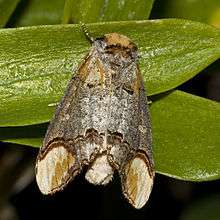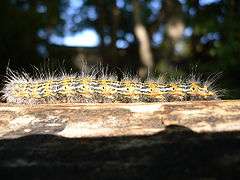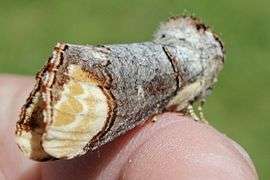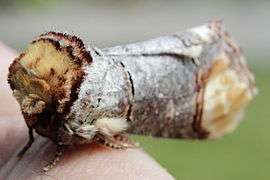Buff-tip
The buff-tip (Phalera bucephala) is a moth of the family Notodontidae. It is found throughout Europe and in Asia to eastern Siberia.[1] The species was first described by Carl Linnaeus in his 1758 10th edition of Systema Naturae.
| Buff-tip | |
|---|---|
 | |
| Scientific classification | |
| Kingdom: | |
| Phylum: | |
| Class: | |
| Order: | |
| Family: | |
| Genus: | |
| Species: | P. bucephala |
| Binomial name | |
| Phalera bucephala | |

Description
This is a fairly large, heavy-bodied species with a wingspan of 55–68 mm. The forewings are grey with a large prominent buff patch at the apex. As the thoracic hair is also buff, the moth resembles a broken twig when at rest. The hindwings are creamy white. This moth flies at night in June and July and sometimes comes to light, although it is not generally strongly attracted.
The young larvae are gregarious, becoming solitary later. The older larva is very striking, black with white and yellow lines. It feeds on many trees and shrubs (see list below). The species overwinters as a pupa.
- ^ The flight season refers to the British Isles. This may vary in other parts of the range.
Recorded food plants
For details see Robinson et al., 2010.[2]
Subspecies
- P. b. bucephala
- P. b. tenebrata
Gallery
- Eggs
 Caterpillar
Caterpillar- Adult in profile
 Adult back
Adult back Adult front
Adult front Male
Male- Habitat
References
- Heath, John; Maitland Emmet, A, eds. (1983). The Moths and Butterflies of Great Britain and Ireland. Volume 9. Sphringidae - Noctuidae. Colchester: Harley Books. p. 41.
- Robinson, Gaden S.; Ackery, Phillip R.; Kitching, Ian J.; Beccaloni, George W.; Hernández, Luis M. (2010). "Search the database - introduction and help". HOSTS - A Database of the World's Lepidopteran Hostplants. Natural History Museum, London.
- Chinery, Michael (1991). Collins Guide to the Insects of Britain and Western Europe.
- Skinner, Bernard (1984). The Colour Identification Guide to Moths of the British Isles.
Further reading
- South R. (1907) The Moths of the British Isles, (First Series), Frederick Warne & Co. Ltd., London & NY: 359 pp. online
External links
| Wikimedia Commons has media related to Phalera bucephala. |
- Kimber, Ian. "71.025 BF1994 Buff-tip Phalera bucephala (Linnaeus, 1758)". UKMoths. Retrieved 30 July 2019.
- Fauna Europaea
- Lepiforum e.V.